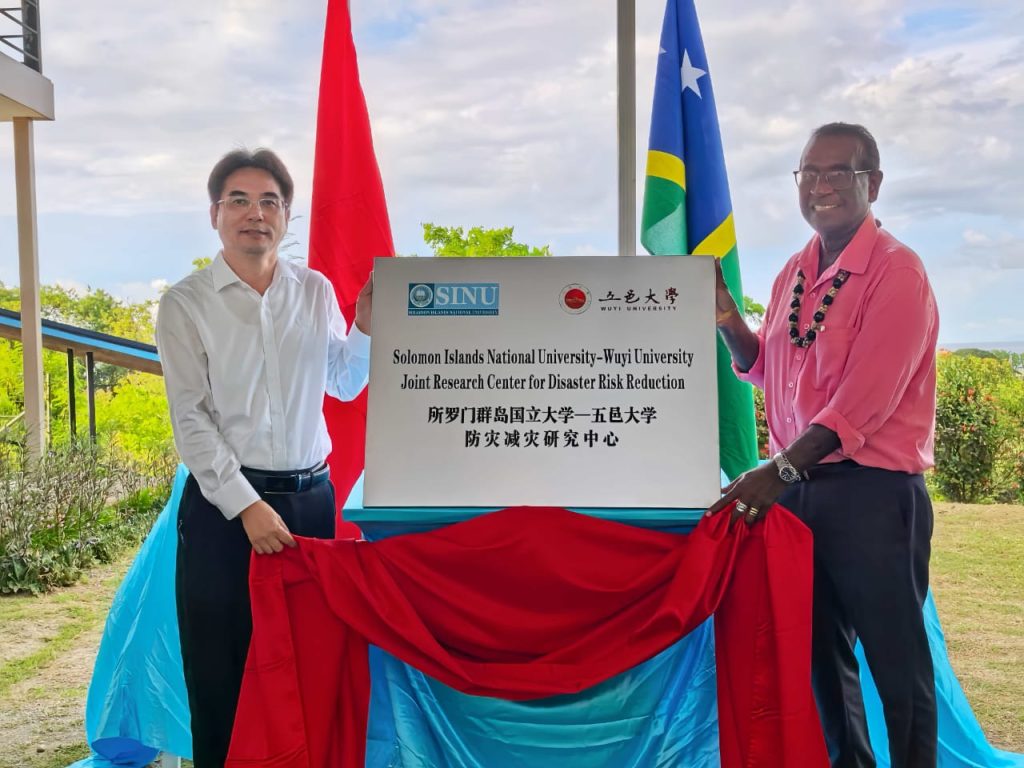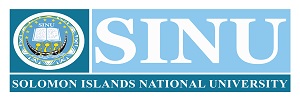
Professor Chen Wenhua, Vice President of Wuyi University, and SINU’s Vice Chancellor at the official signing of the Joint Laboratory for Disaster Prevention and Mitigation. Standing behind them, witnessing the signing, are Ms. Peng Yaqiong, Principal Staff Member (Level 3) of the Risk Monitoring and Comprehensive Disaster Reduction Division, Emergency Management Department, Guangdong Province, China; and Dr. Clyde Puilingi, Dean of the Faculty of Science and Technology, Solomon Islands National University.
Press Release
21 November 2025
Landmark partnership strengthens Solomon Islands’ research capacity, early-warning systems and regional disaster resilience.
Solomon Islands National University (SINU) yesterday (20 November 2025) marked a historic milestone in strengthening national and regional disaster preparedness with the official unveiling of the Wuyi University–SINU Joint Laboratory for Disaster Prevention and Mitigation at its Kukum Campus.
The ceremony brought together government leaders, academic officials, development partners, and a high-level delegation from China’s Emergency Management Department of Guangdong Province, the Jiangmen Municipal Government and Wuyi University, reflecting a strong spirit of international cooperation in the face of increasing climate and disaster risks.
Leading the ceremony, SINU Vice-Chancellor Professor Transform Aqorau described the opening of the Joint Laboratory as far more than a ceremonial act.
“Today is not only the unveiling of a plaque; it is the unveiling of a shared ambition, a commitment to protect our people, strengthen our science, and build resilience in a time of escalating climate and disaster risks,” Professor Aqorau said.
The Vice-Chancellor formally welcomed Mr. Zhong Youguo, Deputy Director-General of the Emergency Management Department of Guangdong Province, alongside representatives from risk monitoring, emergency management, international cooperation and academia from Wuyi University.
Local leadership and academia were represented by Pro-Chancellor and Chair of Council Dr. Morgan Wairiu, Dean of the Faculty of Science and Technology (FST) Dr. Clyde Puilingi, government officials, SINU staff and students.
In his address, Professor Aqorau highlighted that the Joint Laboratory directly responds to gaps identified in the recently completed Climate Vulnerability and Risk Assessment (CVRA) Framework for the Solomon Islands, including:
- Limited quantitative climate and hazard data
- Weak early-warning and hazard monitoring systems
- Insufficient emergency response technology and capacity
- Low adaptive capacity in highly vulnerable communities
“These are not abstract problems. They are real, and they demand a scientific, coordinated, and well-resourced response,” he said.
The Wuyi University–SINU Joint Laboratory will focus on:
- Disaster monitoring and early-warning systems
- Emergency communication technologies
- Rescue equipment and emergency command tools
- Climate modelling and hazard mapping
- Field-based risk assessments
- Training researchers, engineers and emergency management professionals
Delivering his opening remarks, Dr. Puilingi emphasised the significance of the collaboration for SINU, the Pacific region and future generations.
He extended a warm welcome to Professor Zeng Junying, Vice-Dean of the School of Emergency Technology and Management at Wuyi University, along with officials from the Solomon Islands Government and the Embassy of the People’s Republic of China.
“This is more than a partnership. It is a transformational opportunity for SINU and for the Pacific. Wuyi University brings world-class expertise in AI-driven disaster prevention, remote sensing, emergency management and resilient engineering, tools that are essential for our survival in a changing climate,” Dr. Puilingi said.
He noted that the Joint Research Centre for Disaster Risk Reduction, established under an MOU signed earlier this year, will:
- Advance applied and collaborative disaster research
- Strengthen national and community early-warning systems
- Support joint training programmes
- Enable staff and student exchanges
- Introduce modern disaster-management technologies into SINU’s academic curriculum
“For Pacific communities, disasters are not theoretical, they are lived realities. This Centre will translate knowledge into real solutions that protect lives, infrastructure and livelihoods,” he added.
In a frank appeal, Professor Aqorau acknowledged that SINU does not yet have a dedicated building to house the expanding scope of the Joint Laboratory’s work.
“We have the vision, the partnership and the commitment, but we do not yet have the infrastructure,” he said.
He called on government, development partners and international collaborators to support the construction of a new Faculty of Science and Technology complex that would include:
- Disaster simulation rooms
- Climate data and GIS laboratories
- Drone and low-altitude technology testing areas
- Emergency communication and command suites
- Research offices, classrooms and training facilities
“This is not merely a construction project. It is an investment in the safety, resilience and future of the Solomon Islands,” he stressed.
Dr. Puilingi echoed the call, suggesting that the Joint Research Centre be central to any future FST complex, incorporating state-of-the-art laboratories, digital research hubs, remote-sensing facilities and regional training spaces.
“All architectural plans and concept designs will be developed in consultation with our disaster agencies, partners and Wuyi University to ensure this Centre truly reflects the vision of our partnership,” he said.
Both leaders highlighted that this collaboration sets a strong example for the wider Pacific, demonstrating how international expertise and local knowledge can combine to produce sustainable, impactful solutions.
“Imagine a Pacific student trained through this Centre, leading innovations in early-warning systems or resilient infrastructure in their home community. That journey begins here, today,” Dr. Puilingi said.
Professor Aqorau concluded:
“Let this unveiling be a beginning, not an end. Let it lay a cornerstone for long-term resilience, shared progress and regional leadership in disaster preparedness.”
At the conclusion of the ceremony, a public lecture on disaster prevention and mitigation was delivered by Professor Zeng Junying.
Drawing on Wuyi University’s advanced expertise in artificial intelligence, risk modelling, remote sensing and emergency management systems, Professor Zeng shared innovative approaches to:
- Disaster prediction and real-time monitoring
- AI-enhanced early-warning systems
- Rapid response coordination and decision-making
- Post-disaster recovery and resilience planning
The lecture offered valuable insight into how advanced science and technology can be applied in Pacific Island contexts and further underscored the importance of the Joint Laboratory as a platform for knowledge exchange, capacity building and life-saving innovation.
ENDS//
